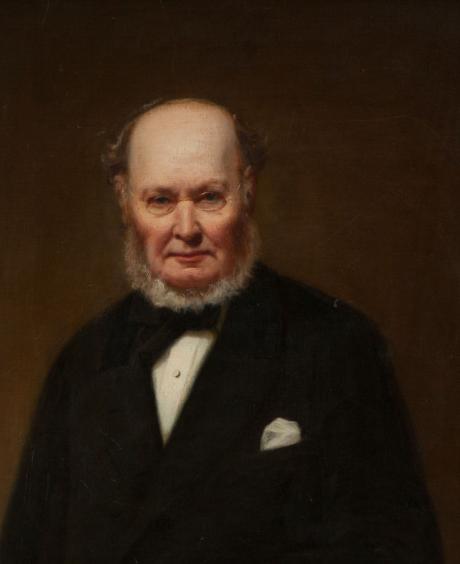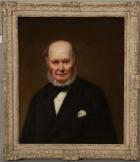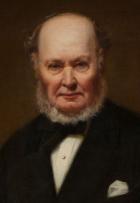Sir James Watson (1801-1889) was an alumnus of the University who became a lawyer and was one of Glasgow's first full-time stockbrokers. He was Lord Provost of Glasgow from 1871 to 1874.
Watson was Chairman of the Glasgow Stock Exchange for twenty-two years from its opening in 1844. He was involved with Lord Provost John Blackie Jr in the Philanthropic Company, set up in 1861 to acquire property for clearance. In 1866 he became the first Deputy Chairman of the City Improvement Trust and he was one of the founders of Glasgow's first three model lodging houses, and of the Mechanics' Institution. He was knighted in 1874.
Herdman, Robert (1828–1888), painter, was born at Rattray, Perthshire, on 17 September 1828, the fourth and youngest son of the Revd William Herdman, minister of that parish, and his wife, Sophia Walker. Herdman attended Rattray parish school until his father died in 1838. The family then moved to St Andrews where he studied for five sessions at Madras College. In 1843 he entered the University of St Andrews, taking the full arts curriculum, and he was a promising Greek scholar. At this time he spent the summer vacations back in Rattray where he enjoyed sketching and painting. This became Herdman's true vocation although he retained a deep belief in the importance of scholarship for the rest of his life. In June 1847 Herdman moved to Edinburgh and entered the Trustees' Academy. He studied first under Robert Ballantyne and later under the inspirational teaching of Robert Scott Lauder. He was one of a group of particularly gifted students which included William McTaggart, George Paul Chalmers, and John Pettie, and he was successful himself, winning prizes in 1848, 1850, 1851, and 1852. He attended the Royal Scottish Academy life school between 1852 and 1855 under the tuition of James Drummond. In 1854 Herdman won the academy's newly established Keith prize for the best historical picture in the Royal Scottish Academy's annual exhibition by a student and in 1855 he won the academy's bronze medal.
In the mid-1850s the Royal Scottish Academy was expanding its collection of copies of old masters for use as teaching aids. At Herdman's request Robert Scott Lauder recommended him to the academy's council to undertake the task of making old master copies. Herdman was duly commissioned to travel to Florence to copy one of Masaccio's frescoes in the Brancacci Chapel, Santa Maria del Carmine. On his return to Edinburgh further watercolours after Masaccio, Perugino, Raphael, and others were shown to the council who duly purchased a total of nine paintings including The Agony in the Garden, after Perugino (c.1855–1856; Royal Scottish Academy, Edinburgh). The impact of Herdman's months in Italy was profound. Not only did his study of early and high Renaissance art have a deep impact on his own work but the light, colours, and exoticism of everyday Italian life inspired a lengthy series of paintings over the next few years. As well as painting the street life of itinerant musicians or pifferari, he painted more general subjects such as The Mandolin Player(1856; Perth Museum and Art Gallery) in which a woman instrumentalist is seated in a window before a distant landscape reminiscent of Italy.
Robert Herdman first exhibited at the Royal Scottish Academy annual exhibitions in 1850 and remained a regular contributor for the rest of his life. On 17 September 1857 he married Emma Catherine Abbott (1835–1890) in Edinburgh. He rapidly became an established figure in the Edinburgh art world and was elected an associate of the Royal Scottish Academy in 1858 and an academician in 1863 when he was only thirty-four. His diploma work, La culla (1864; Royal Scottish Academy), shows the continuing influence of Italy in its title and treatment of a Madonna-like mother and child set amid the suggestion of Roman ruins. Painted in a broad, direct manner it is characteristic of his style. During this period Robert Herdman also built up a successful portrait painting practice in Edinburgh. Among his sitters were Lady Shand (1867; NG Scot.) and Thomas Carlyle (1875; Scottish National Portrait Gallery, Edinburgh) as well as many artists and their families.
Robert Herdman was profoundly interested in Scottish history and he painted many works on such subjects as the life of Mary, queen of Scots, and the covenanters. The Conference between Queen Mary and John Knox at Holyrood Palace, 1561 (1875; Perth Museum and Art Gallery) presents a dramatic rendering of a moment in Scottish history that also underlines the issue of historical religious divisions within the country; his covenanting subjects such as After the Battle: a Scene in Covenanting Times (1870; NG Scot.) deal with the hardships and human loss suffered in the name of religion. These Scottish subject paintings were very popular, indeed After the Battle was commissioned by the Royal Association for the Promotion of the Fine Arts in Scotland (RAPFAS) to be engraved and disseminated to a wide audience. Between 1863 and 1878 Herdman contributed to twelve RAPFAS volumes of engravings, mostly subjects based on the novels of Sir Walter Scott. Another area of interest was Celtic legend and religion, particularly the life of St Columba, for example St Columba Rescuing a Captive (1883; Perth Museum and Art Gallery).
Unlike many of his contemporaries, Herdman did not settle in London although he did exhibit at the Royal Academy between 1863 and 1878. He remained in Edinburgh but also spent time on Arran, painting landscapes, and also visited Mull. He spent the winter of 1868–9 in Italy and made many watercolour studies of Venice. His continuing interest in watercolours led him to become a founder member of the Royal Scottish Society of Painters in Watercolour in 1878.
Robert Herdman died suddenly on 10 January 1888 at his home at St Bernard's, 12 Bruntsfield Crescent, Edinburgh, and was buried in Grange cemetery, Edinburgh, on 14 January. He was survived by his wife and children among whom were the painter Robert Duddingstone Herdman and the marine zoologist Sir William Abbott Herdman. In the last few days of his life he had been preparing an address to the art students of the board of manufactures' school in Edinburgh (the Trustees' Academy). Published posthumously, for distribution to the students, it summarizes Herdman's belief in the importance not only of mastering the technical and aesthetic aspects of fine art but also of developing a wider cultural awareness and understanding.
Joanna Soden DNB



